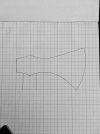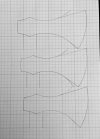It’s far from perfect but there are so many subtleties to the design as I’m learning
You're doing Great.Wish that i had the stick-with-it-ness to diagram design so neatly....
The important thing to keep in mind is that these shapes are Anything but random.
These lines add up to cumulative experience accrued by generations of skilled labor,both forging and woodworking.(Indeed those fantastically-beautiful,hydro-dynamic shapes of various viking-age ships come from the way these axes Work,directly).
Remember that this very form has started out as a turd-shaped lump of iron(called "asmund" in Swedish as i learned just yesterday),and that it was carefully formed into what we see in a finished object.
Not cut,or spliced,but gently and gradually reshaped,molded.That also has a lot of bearing on the shape.
I'm fairly regularly humbled by these shapes,in spite of all the hot air i may blow...

Couple years ago i had to approximate something similar,but a more modern version by Steffen Rohnnquist...I did So poorly that i even surprised myself...And i tried twice,blowing it both times!
So,"Learning" is the key-word for all of us here...
In these photos the first two are my attempts,in the third-two of Rohnnquist's originals and mine on the right...I wasn't even close!
 https://imgur.com/a/hECh1
https://imgur.com/a/hECh1
So,again,the best of luck!


